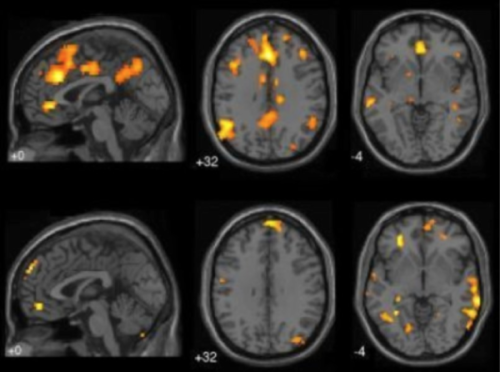So what is actually happening in your brain when you stare into space, or when you let your mind wander? Turns out, a LOT.
We may think—mistakenly— that nothing important is happening in our heads when we aren’t consciously doing something; when our mind is wandering away from the task at hand.
But actually, our brain lights up like a Christmas tree when we’re daydreaming. Many regions in the brain become active—far more than when we are focusing.
Take a look at these images. In this one, you can see a comparison of when a mind is wandering (top 3 images), compared to when the subject’s brain was focusing on solving a problem (bottom 3 images).

The yellow and orange areas of this fMRI image indicate active areas of the brain. As you can see, far more of the brain is more active when we daydream than when we focus on a problem. What is fascinating to me about these images is just how much of the brain is working when we daydream, and the diversity of brain regions that come online when we aren’t consciously thinking about or working on anything.
When we daydream, or relax our focus, our brain begins drawing connections between all the things that it previously didn’t see as all that connected. Importantly, the brain networks that are responsible for creative insight come online.
There’s a neuro-biological story behind this. We have two primary attentional networks in our brain: task positive and task negative, and they function like a see-saw in that only one is active at a time.
When we are focused on something, or using our willpower to do something, the task-positive attentional network is ON. (And the task negative — mind wandering, daydreaming, “time wasting” –network is OFF.) We give credit to our task-positive attentional network for all the great work we do in the world. When we are focused, we write books. We build bridges. We raise children. Our culture tells us to focus, and that that’s the only way to get anything done around here.
But when you’re staring out the window, out into space, relaxing, or driving but not listening to the radio and you let your mind wander, the task-negative brain becomes active. All those neurons start making connections between things you didn’t see before, usually at an unconscious level. This is where our creative insight comes from. We can’t solve problems or do much of anything without the insights that come from that downtime. We certainly can’t fulfill our potential without filling our need for creative insight, without nurturing our ability to draw connections. This is why we often get our best ideas in the shower…it’s the only remaining place in the world where we let ourselves do nothing!
All of this explains other research that shows that conscious, effortful thinking does nothing to improve creativity, or to help people come up with innovative solutions to problems. For example: When researchers give people a task that requires creativity (such as instructions to come up with a list of ways to use a brick), people don’t generate longer or more creative lists if they have a few extra minutes to think before they start.
For example: When researchers give people a task that requires creativity (such as instructions to come up with a list of ways to use a brick), people don’t generate longer or more creative lists if they have a few extra minutes to think before they start.
What does help? Spending those few extra minutes not consciously thinking about the task, by diverting the research subjects’ attention with an unrelated task. This then gives the insight-generating part of the brain time to get to work making connections. Those new connections are, essentially, innovations that improve our performance on creative tasks.
Here’s what I want you to take away from all of this:
Creative insight is at the very heart of the sweet spot–that place of both power and ease, that place where we humans hit our home runs. Nothing is easier than an “aha moment” that pops effortlessly into your awareness, and nothing is more powerful.
What this means is that you will not find your sweet spot, or find flow, or do your best work, without cultivating stillness in your life, without spending a good part of each just staring into space.
That’s such a counter-culture notion that many people feel guilty and anxious staring into space. We feel important and productive when we are busy, and insignificant and lazy day dreaming. But to be successful, we don’t just need to learn to tolerate stillness, we actually need to cultivate it.
This post is from a series about “strategic slacking” from the “Science of Finding Flow,” an online course I created as a companion to my book The Sweet Spot: How to Accomplish More by Doing Less. Want to go on to the next class or start the course from the beginning? It’s free! Just go to The Science of Finding Flow course page. Enjoy!

